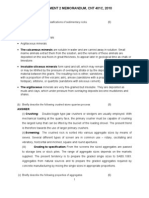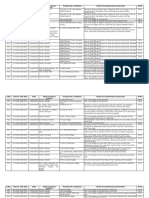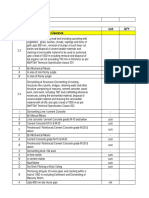Assignment 2
Uploaded by
hfzhnAssignment 2
Uploaded by
hfzhn2.
1 Methods of Concrete Compaction
Concrete Compaction is the process adopted for expelling the entrapped air from the concrete. In the process of mixing, transporting and placing of concrete air is likely to get entrapped in the concrete. The lower the workability, higher is the amount of air entrapped. In other words, stiff concrete mix has high percentage of entrapped air and, therefore, would need higher compacting efforts than high workable mixes. In order to achieve full compaction and maximum density, with reasonable compacting efforts available at site, it is necessary to use a mix with adequate workability. It is also of common knowledge that the mix should no t be to o wet for easy compaction which also reduces the strength of concrete. For maximum strength, driest possible concrete should be compacted 100 per cent. The overall economy demands 100 percent compaction with reasonable compacting efforts available in the field. The following methods are adopted for compacting concrete: 1. Hand Compaction o Rodding o Ramming o Tamping 2. Compaction by Vibration o Internal vibrator (Needle vibrator) o Formwork vibrator (External vibrator) o Table vibrator o Platform vibrator o Surface vibrator (Screed vibrator) o Vibratory Roller 3. Compaction by Pressure and Jolting 4. Compaction by Spinning
2.2 Possible Properties of Concrete Affected By Low Compaction
Low compaction of concrete may increase the air voids in the concrete itself. As a result, the strength of the concrete will be weaker. This is because the air void reduce the strength and become the weak point of the concrete. When the amount of air void increase, the concrete permeability increase and will reduce concrete durability. If the concrete is not dense and impermeable, it will not be watertight. It will les able to withstand aggressive liquid and its expose surface will weather easily. There also might cause honeycomb at the concrete.
2.3 Methods Used For Hand Compaction
Hand compaction is used for ordinary and unimportant structures. Workability should be decided in such a way that the chances of honeycombing should be minimum. The various methods of hand compaction are as given below: 1. Rodding: a method of poking with 2 m long, 16 mm diameter rod at sharp corners and edges. The thickness of layers for rodding should be 15-20 cm 2. Ramming: generally used for compaction on ground in plain concrete. It is not used either in RCC or on upper floors 3. Tamping: It is a method in which the top surface is beaten by wooden cross beam of cross section 10 cm x 10cm. Both compaction and levelling are achieved simultaneously. It is mainly used for roof slabs and road pavements
2.4 Methods Used For Compaction By Vibration
Vibration is imparted to the concrete by mechanical means. It causes temporary liquefaction so that air bubbles come on to the top and expelled ultimately 1. Internal vibration: most commonly used technique of concrete vibration. Vibration is achieved due to eccentric weights attached to the shaft. The needle diameter varies from 20mm to 75 mm and its length varies from 25 cm to 90 cm. The frequency range adopted is normally 3500 to 5000rpm 2. External vibration: adopted where internal vibration cant be used due to either thin sections or heavy reinforcement. External vibration is less effective and it consumes more power as compared to the internal vibration. The formwork also has to be made extra strong when external vibration is used 3. Table vibration: mainly used for laboratories where concrete is put on the table 4. Platform vibration: similar to table vibrators but these are generally used on a very large scale 5. Surface vibration: also called as screed board vibrators. The action is similar to that of tamping. The vibrator is placed on screed board and vibration is given on the surface. It is mainly used for roof slabs, road pavements etc. but it is not effective beyond 15 cm depth
2.5 Concrete Compaction in Congested Reinforcements & Impossible Internal Vibration
The reinforcements lie very close to each other, greater care is taken in vibrating so that no pockets or collections of grout are formed. Except where some of the concrete has already set and provided that the reinforcement is adequately supported and secured, the vibrator be pressed against the reinforcement.
2.6 Examples of Compaction by Spinning
Spinning is one of the recent methods of compaction of concrete. This method of compaction is adopted for the fabrication of concrete pipes. The plastic concrete when spun at a very high speed, gets well compacted by centrifugal force. This method is generally used for compacting concrete pipes
2.7 Techniques of Water Curing
Various techniques of curing are adopted in the field as given below: 1. Replenishing the lost water a. by immersion of water b. by ponding c. by sprinkling d. u s i n g s a t u r a t e d c o ve r i n g s , e . g . j u t e b a g s e t c . 2. Preventing loss of moisture a. using curing compounds b. using impermeable membrane coverings *Important observations regarding curing 1. Curing should be started earliest as possible 2. F o r t h e p o r t i o n o f c o n c r e t e wh i c h i s c o ve r e d with formwork, the curing should be started as soon as the formwork is removed. 3. O n e xp o s e d s u r f a c e , i t s h o u l d b e s t a r t e d wh e n concrete has sufficiently hardened such that it doesnt get disturbed by curing. 4. E n s u r e u n i n t e r r u p t e d c u r i n g . I f i t wa s discontinued for any reason, the reaction of hydration will be stopped permanently. The partial hydration makes the capillary pores discontinuous and water cant enter the concrete even if the curing is started again. 5. H i g h s t r e n g t h c o n c r e t e s h o u l d b e c u r e d a t a n early age. 6. T h e r e i s a wi d e s p r e a d b e l i e f t h a t h u mi d c l i ma t e is sufficient and curing is not required in rainy season. 7. T h e p e r s o n g e n e r a l l y e n t r u s t e d f o r c u r i n g i s t h e most unskilled person. He doesnt appreciate the importance of curing. In fact he believes that curing is a process of wastage of water, time and money. 8. I t c a n t b e ma d e a m e a s u r a b l e i t e m i n t h e contract. Therefore the best and practical method to ensure proper curing is the education of the person who is responsible for curing. Once he understands the importance of curing, he would certainly ensure it.
7
You might also like
- Details of WDETAILS OF WATER SAMPLING STATION - Pdfater Sampling StationNo ratings yetDetails of WDETAILS OF WATER SAMPLING STATION - Pdfater Sampling Station31 pages
- BS 7861 Part 1 2007 Strata Reinforcement Support System Components in Co...No ratings yetBS 7861 Part 1 2007 Strata Reinforcement Support System Components in Co...52 pages
- Fresh Concrete: Batching, Mixing, Transportation, Placing: Lecture No. 07100% (1)Fresh Concrete: Batching, Mixing, Transportation, Placing: Lecture No. 0725 pages
- Concrete Works at The Construction SiteNo ratings yetConcrete Works at The Construction Site12 pages
- Concreting: Civil Engineering Materials 267No ratings yetConcreting: Civil Engineering Materials 26714 pages
- Concrete Technology: Yassin Ali Ibrahim Erbil Polytechnic University Erbil Technology Institute 2020-2021100% (1)Concrete Technology: Yassin Ali Ibrahim Erbil Polytechnic University Erbil Technology Institute 2020-2021112 pages
- Compaction of Concrete Methods, Defects & Importa100% (1)Compaction of Concrete Methods, Defects & Importa12 pages
- G4-Concrete Test Specimens Preparation in LaboratoryNo ratings yetG4-Concrete Test Specimens Preparation in Laboratory4 pages
- 00 Concrete Construction Troubleshooting TipsNo ratings yet00 Concrete Construction Troubleshooting Tips20 pages
- Finishing & Curing of Concrete: MethodsNo ratings yetFinishing & Curing of Concrete: Methods28 pages
- Pour Compact and Finish Concrete Construction100% (1)Pour Compact and Finish Concrete Construction23 pages
- Concrete Proportion and Concrete Mixture RatioNo ratings yetConcrete Proportion and Concrete Mixture Ratio58 pages
- CE Lecture 8 (Plain Concrete Finishing Works)100% (1)CE Lecture 8 (Plain Concrete Finishing Works)42 pages
- Gambella University: Department of Civil Engineering Construction Material Chapter Three (B) - ConcreteNo ratings yetGambella University: Department of Civil Engineering Construction Material Chapter Three (B) - Concrete117 pages
- Curing of Concrete: N EDG.: Emester:-BranchNo ratings yetCuring of Concrete: N EDG.: Emester:-Branch28 pages
- Material & Construction 2: Credit Hours 3 Session Per Week: 1No ratings yetMaterial & Construction 2: Credit Hours 3 Session Per Week: 194 pages
- 8. PDF-Concrete and Water Cement Ratio week-8No ratings yet8. PDF-Concrete and Water Cement Ratio week-825 pages
- Fem Based Analysis of Wing Wall To Culvert ConnectionNo ratings yetFem Based Analysis of Wing Wall To Culvert Connection8 pages
- Critical Review On Risk Assessment Among Construction WorkersNo ratings yetCritical Review On Risk Assessment Among Construction Workers7 pages
- Setting The Standard in Transport Oriented Developments: Malaysian Resources Corporation Berhad Annual Report 2015No ratings yetSetting The Standard in Transport Oriented Developments: Malaysian Resources Corporation Berhad Annual Report 2015336 pages
- Compressive and Tensile Strength of Concrete Using Lateritic Sand and River Sand As Fine AggregateNo ratings yetCompressive and Tensile Strength of Concrete Using Lateritic Sand and River Sand As Fine Aggregate7 pages
- Documented Information Syllabus Capiz State University Vision: MissionNo ratings yetDocumented Information Syllabus Capiz State University Vision: Mission11 pages
- Timber Frame Construction - Wood Frame Construction - Timber Frame Homes - Timber Buildings - Understand Building ConstructionNo ratings yetTimber Frame Construction - Wood Frame Construction - Timber Frame Homes - Timber Buildings - Understand Building Construction3 pages
- Fosroc Conplast SP454S: High Performance Superplasticising AdmixtureNo ratings yetFosroc Conplast SP454S: High Performance Superplasticising Admixture2 pages
- List of Unauthorized Construction of Building Department-I, South Zone 01.02.2019 To 31.07.2019No ratings yetList of Unauthorized Construction of Building Department-I, South Zone 01.02.2019 To 31.07.201910 pages
- N113 - Long Span Construction Between P73 A - 220813 - 083735No ratings yetN113 - Long Span Construction Between P73 A - 220813 - 08373576 pages
- Assessment, Reliability and Maintenance of Masonry Arch Railway Bridges in EuropeNo ratings yetAssessment, Reliability and Maintenance of Masonry Arch Railway Bridges in Europe10 pages
- Analysis of Segmentally Constructed Prestressed Concrete Bridges Using Hexahedral Elements With Realistic Tendon ProfilesNo ratings yetAnalysis of Segmentally Constructed Prestressed Concrete Bridges Using Hexahedral Elements With Realistic Tendon Profiles9 pages
- Specification of Stainless Steel Pipe Fittings and FlangesNo ratings yetSpecification of Stainless Steel Pipe Fittings and Flanges1 page
- Behavior of Cellular Beams With Sinusoidal Openings: S. Durif and A. BouchaïrNo ratings yetBehavior of Cellular Beams With Sinusoidal Openings: S. Durif and A. Bouchaïr6 pages
- Dura-Blue: PVC Municipal Water Distribution Pipe (4 - 12")No ratings yetDura-Blue: PVC Municipal Water Distribution Pipe (4 - 12")3 pages
- Details of WDETAILS OF WATER SAMPLING STATION - Pdfater Sampling StationDetails of WDETAILS OF WATER SAMPLING STATION - Pdfater Sampling Station
- BS 7861 Part 1 2007 Strata Reinforcement Support System Components in Co...BS 7861 Part 1 2007 Strata Reinforcement Support System Components in Co...
- Fresh Concrete: Batching, Mixing, Transportation, Placing: Lecture No. 07Fresh Concrete: Batching, Mixing, Transportation, Placing: Lecture No. 07
- Concrete Technology: Yassin Ali Ibrahim Erbil Polytechnic University Erbil Technology Institute 2020-2021Concrete Technology: Yassin Ali Ibrahim Erbil Polytechnic University Erbil Technology Institute 2020-2021
- G4-Concrete Test Specimens Preparation in LaboratoryG4-Concrete Test Specimens Preparation in Laboratory
- Gambella University: Department of Civil Engineering Construction Material Chapter Three (B) - ConcreteGambella University: Department of Civil Engineering Construction Material Chapter Three (B) - Concrete
- Material & Construction 2: Credit Hours 3 Session Per Week: 1Material & Construction 2: Credit Hours 3 Session Per Week: 1
- How to Build a Simple Three Bedroom Shipping Container HouseFrom EverandHow to Build a Simple Three Bedroom Shipping Container House
- Fem Based Analysis of Wing Wall To Culvert ConnectionFem Based Analysis of Wing Wall To Culvert Connection
- Critical Review On Risk Assessment Among Construction WorkersCritical Review On Risk Assessment Among Construction Workers
- Setting The Standard in Transport Oriented Developments: Malaysian Resources Corporation Berhad Annual Report 2015Setting The Standard in Transport Oriented Developments: Malaysian Resources Corporation Berhad Annual Report 2015
- Compressive and Tensile Strength of Concrete Using Lateritic Sand and River Sand As Fine AggregateCompressive and Tensile Strength of Concrete Using Lateritic Sand and River Sand As Fine Aggregate
- Documented Information Syllabus Capiz State University Vision: MissionDocumented Information Syllabus Capiz State University Vision: Mission
- Timber Frame Construction - Wood Frame Construction - Timber Frame Homes - Timber Buildings - Understand Building ConstructionTimber Frame Construction - Wood Frame Construction - Timber Frame Homes - Timber Buildings - Understand Building Construction
- Fosroc Conplast SP454S: High Performance Superplasticising AdmixtureFosroc Conplast SP454S: High Performance Superplasticising Admixture
- List of Unauthorized Construction of Building Department-I, South Zone 01.02.2019 To 31.07.2019List of Unauthorized Construction of Building Department-I, South Zone 01.02.2019 To 31.07.2019
- N113 - Long Span Construction Between P73 A - 220813 - 083735N113 - Long Span Construction Between P73 A - 220813 - 083735
- Assessment, Reliability and Maintenance of Masonry Arch Railway Bridges in EuropeAssessment, Reliability and Maintenance of Masonry Arch Railway Bridges in Europe
- Analysis of Segmentally Constructed Prestressed Concrete Bridges Using Hexahedral Elements With Realistic Tendon ProfilesAnalysis of Segmentally Constructed Prestressed Concrete Bridges Using Hexahedral Elements With Realistic Tendon Profiles
- Specification of Stainless Steel Pipe Fittings and FlangesSpecification of Stainless Steel Pipe Fittings and Flanges
- Behavior of Cellular Beams With Sinusoidal Openings: S. Durif and A. BouchaïrBehavior of Cellular Beams With Sinusoidal Openings: S. Durif and A. Bouchaïr
- Dura-Blue: PVC Municipal Water Distribution Pipe (4 - 12")Dura-Blue: PVC Municipal Water Distribution Pipe (4 - 12")


































































































